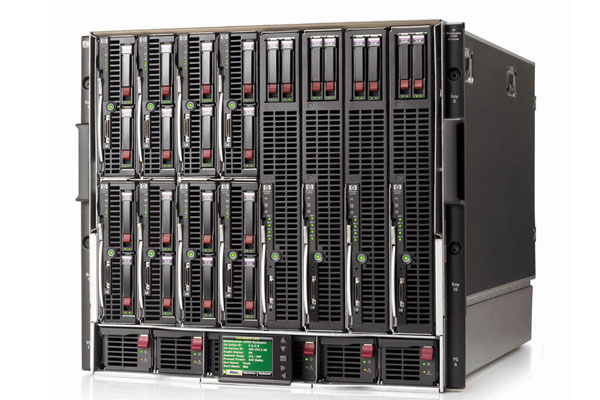HP BladeSystem c-Class
Does HP's latest c-Class server maintain the award winning performance of its predecessor? Dave Mitchell finds out.


HP's BladeSystem c-Class continues to set the bar. HP offers an extensive range of server and switch blades with some interesting storage options and excellent build quality. Management and monitoring facilities are far superior to the competition and the latest power control and metering tools could prove invaluable to data centres.

All server blades have integrated USB ports on their motherboards for attaching security dongles or booting servers from flash memory. Virtualisation is a natural application for blade servers and HP takes this a step further as the USB port can now be used to boot diskless blades with a virtualisation kernel environment with VMware or XenSource available as options.
Even PC blade applications get a look in as the latest xw460c enables you to deliver workstation services to end users but physically maintain data and systems within the data centre. It has a couple of hot-swap drive bays and integral RAID, whilst graphics have a high profile as one of the blade's mezzanine slots is home to an nVidia controller. HP also offers software that can compress the video feed passing over the network to reduce overheads.
HP's network interconnect portfolio has been augmented with some new 10GbE switch blades. These offer a pair of high-speed fibre ports and teaming these up with the new server blade mezzanine cards enables you to implement end-to-end 10GbE. The chassis also accommodates HP's latest VC (virtual connect) module which originally came with a pair of 10GbE CX-4 copper ports, but a version is now available with quad Gigabit, two 10GbE fibre and a CX4 copper port as well.
HP's virtual connect modules enable change management and security procedures to be applied to control and authorise server deployments. These are now offered in Gigabit and 10GbE versions and can be used to assign MAC addresses from a virtual pool when new blades are installed. This comes into its own for server redundancy as a failed server in one chassis can be replaced by a hot-standby server in another linked chassis and its MAC addresses will be passed across to the new server.
Management facilities simply don't get any better with the chassis looked after by HP's Onboard Administrator. This delivers a wealth of operational information in a well designed interface and it now enables multiple chassis to be managed from a single interface. All you do is link the management modules from each chassis together and they'll all appear in the home page for selection. Every server blade has its own embedded iLO2 chip so can also be accessed and managed individually.
Power usage in data centres in a big issue and we were impressed with the facilities HP now offers to manage and control this. From the Onboard Administrator you can keep a close eye on chassis overall draw and put limits on maximum consumption. The dynamic power mode is used to control which supplies come online based on the power requirements of installed modules. Server blades have their power requirements controlled with the Power Meter, Power Regulator and Power Cap features.
The Power Regulator dynamically controls AMD and Intel processor consumption by throttling them back during periods of low demand. Alternatively, you can set them to run at their lowest speed or go for the highest performance if you wish. The Power Meter provides a graph showing peak and average consumption in Watts or Btu/hr and can pass this information to the database in HP's System Insight Manager enabling power trends to be viewed. Last up is Power Cap, which enables you to set physical limits in Watts or Btu/hr on your servers to reduce overall power consumption and heat output.
Sign up today and you will receive a free copy of our Future Focus 2025 report - the leading guidance on AI, cybersecurity and other IT challenges as per 700+ senior executives
HP may not offer as big a variety of server blades as IBM but it has every Intel and AMD variant covered. The chassis itself is far better built and designed than the alternatives from IBM, Dell and Fujitsu Siemens and the power management options will prove to be extremely valuable. We were mightily impressed with the BladeSystem c-Class when we first saw it and there's nothing here that'll make us change our minds.
Verdict
HP's BladeSystem c-Class continues to set the bar. HP offers an extensive range of server and switch blades with some interesting storage options and excellent build quality. Management and monitoring facilities are far superior to the competition and the latest power control and metering tools could prove invaluable to data centres.
Chassis: 7000c 10U enclosure with sixteen half-height slots Power: Up to six hot-swap single-phase or two three-phase Fans: Up to ten hot-swap module bays - four minimum Expansion: Eight network interconnect module bays Management: Two management blade slots
Dave is an IT consultant and freelance journalist specialising in hands-on reviews of computer networking products covering all market sectors from small businesses to enterprises. Founder of Binary Testing Ltd – the UK’s premier independent network testing laboratory - Dave has over 45 years of experience in the IT industry.
Dave has produced many thousands of in-depth business networking product reviews from his lab which have been reproduced globally. Writing for ITPro and its sister title, PC Pro, he covers all areas of business IT infrastructure, including servers, storage, network security, data protection, cloud, infrastructure and services.
-
 Trump's AI executive order could leave US in a 'regulatory vacuum'
Trump's AI executive order could leave US in a 'regulatory vacuum'News Citing a "patchwork of 50 different regulatory regimes" and "ideological bias", President Trump wants rules to be set at a federal level
By Emma Woollacott Published
-
 Microsoft Excel is still alive and kicking at 40 – and it's surging in popularity as 82% of finance professionals report ‘emotional attachment’ to the spreadsheet software
Microsoft Excel is still alive and kicking at 40 – and it's surging in popularity as 82% of finance professionals report ‘emotional attachment’ to the spreadsheet softwareNews A recent survey found Gen Z and Millennial finance professionals have a strong “emotional attachment” to Microsoft Excel
By Emma Woollacott Published
-
 LastPass hit with ICO fine after 2022 data breach exposed 1.6 million users – here’s how the incident unfolded
LastPass hit with ICO fine after 2022 data breach exposed 1.6 million users – here’s how the incident unfoldedNews The impact of the LastPass breach was felt by customers as late as December 2024
By Emma Woollacott Published
